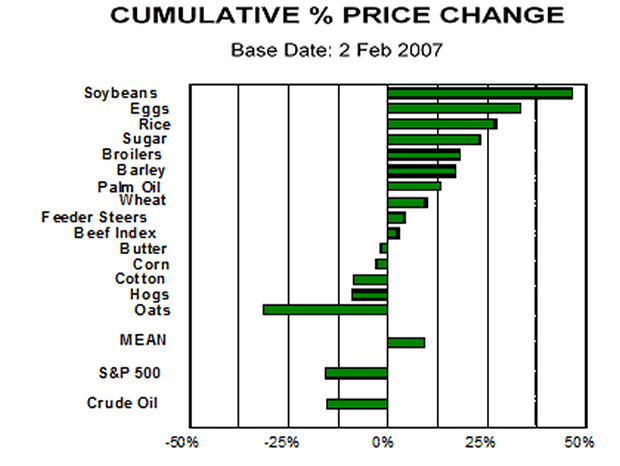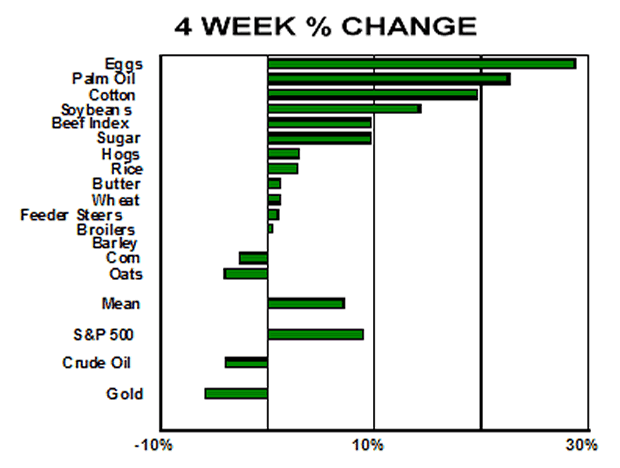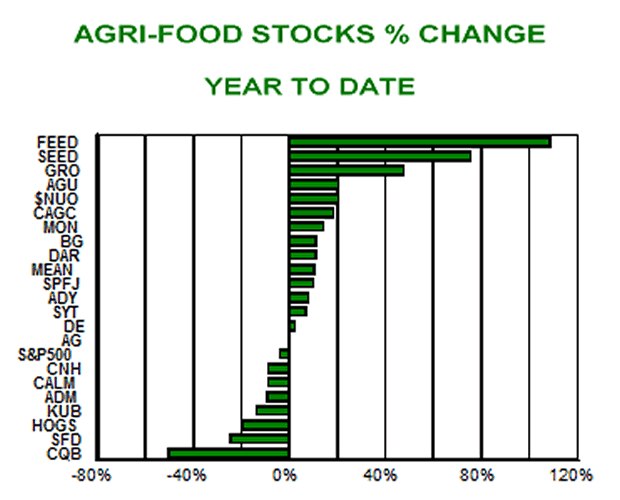Agri-Foods an Offensive Investment Strategy Against Inflation
Commodities / Agricultural Commodities Apr 21, 2009 - 12:39 PM GMTBy: Ned_W_Schmidt
 Where to put your next egg? That question receives a lot of thought by investors as the Bernanke/Obama Bear Market continues unabated. As always with complex questions , some simple answers exist. For example, if you had put your nest egg in eggs, one would have done better than the U.S. equity market. That is one of the many messages in our first chart this week. It portrays the return on the more important Agri-Food commodity prices compared to the S&P 500 and oil over the past two plus years. The mean return on this basket of commodities for this period of measurement is +9% versus -15% for the S&P 500.
Where to put your next egg? That question receives a lot of thought by investors as the Bernanke/Obama Bear Market continues unabated. As always with complex questions , some simple answers exist. For example, if you had put your nest egg in eggs, one would have done better than the U.S. equity market. That is one of the many messages in our first chart this week. It portrays the return on the more important Agri-Food commodity prices compared to the S&P 500 and oil over the past two plus years. The mean return on this basket of commodities for this period of measurement is +9% versus -15% for the S&P 500.
U.S. CASH AGRI-FOOD PRICES

Those results are not what would be expected listening to the business media or reading the business press. A good reason exists for that information vacuum. Most media anchors and market strategists when talking about commodities allow their ignorance to spill out. Commodities is not a homogeneous asset group.
Commodities is an asset class that actually includes three sectors. Each of these sectors has different dynamics and economic drivers. One sector is energy which includes oil, natural gas, coal, etc. Second sector is minerals and ores, such as iron, copper, Gold, etc. Third, and most attractive of the three, is Agri-Food, made up of corn, soybeans, hogs, etc. To lump all of these sectors together and assume that any particular set of economic conditions drive all is simple naive and wrong.
Economic collapse in Western economies may indeed frustrate producers of energy and minerals. However, the Asian economic miracle continues to move forward. China's economy has slowed, but not collapsed due to economic mismanagement as has been the case in Western economies. Slowing of China's economic growth to 6% is importantly not due to frailties of that economy, but rather due to the problems in Western economies. We also note that referring to 6% economic growth as slow is rather amusing as it is an economic growth rate absolutely impossible to achieve under the policies of the Obama Regime.
Economic growth of 6% has two other, important, implications. 6% growth in the income of 1.3+ billion people is a lot of additional income. Second, a goodly portion of that incremental income will be spent on food and, importantly, food higher up the value chain. As our second chart, below, shows, continuing expansion of demand for Agri-Food against a shrinking supply is providing positive support for Agri-Food prices.
China's demand for Agri-Food commodities may already beginning to strain the global Agri-Food production system. In soybeans for example, Financial Times (17 April 2009) reports,
"The US government yesterday reported weekly soyabean export sales of 808,300 tonnes, with half heading to China. This strong demand has increased concerns that US soyabean stocks will be severely depleted to less than 100m bushels by the end of the current season."
"One trader warned that the US soyabean market could not allow China to maintain its current pace of buying and that further price increases would be required to ration demand." [Emphasis added.]
Base Agri-Food Components

Considerable excitement has been generated by the bear market rally in U.S. equities this past month. What has not been reported is how well Agri-Food commodities have done in that same period. Those results are shown in the second graph, above. While the S&P 500 did manage a 9% rally in the past month, the average rise for Agri-Foods has been 7%. Note also that several Agri-Food commodity prices did substantially better than the U.S. equity market.
In considering these results, remember an important factor that has yet to influence Agri-Food prices. The massive debt monetization now being done by the U.S. Federal Reserve has yet to have its inevitable impact on the U.S. dollar. But, it will come. Adding to that which has already occurred the further debt monetization necessary to finance out of control federal deficits of the Obama Regime can only lead to collapse of the U.S. dollar's value by 50% or more. As Agri-Foods are priced in dollars, like Gold, the prices of Agri-Food commodities are about to embark on an Elliot Wave III.
Massive structural economic change has been occurring in China for more than two decades. That condition will continue for at least another decade. More wealth will be created in the next ten years in China than has ever been created in any ten-year period of history. Chinese consumers have two traits, one unique and one not, that should not be forgotten. They are intense savers, and will accumulate massive amounts of Gold in coming years. Second, like all consumers with rising incomes they will spend more money on food, and food of a higher quality.
How has the investment world responded to the structural bull market continuing to unfold in Agri-Foods? Well, as our final chart above portrays, they have responded nicely. Year-to-day returns are not particularly magic, but do seem interesting. Our Agri-Food stock group has risen on average 10% since the beginning of the year while the S&P 500 is off 4%. While some remain mired in discussions of which bank stock might survive, Agri-Food socks seem to have shaken off the oppressive crush of the hedge fund liquidation.

Most enlightened investors have already established Gold positions as a form of Wealth Insurance. Gold, however, is still largely a defensive investment. Gold investors are trying to defend their wealth from those in governments, such as the U.S. Congress and the Obama Regime, that seek to destroy wealth. Agri-Food investments might be considered as an offensive investment to complement your Gold positions. With Agri-Food we have a unique situation. 1.3+ billion people in China, and the government of those 1.3+ billion people, are striving to be able to spend money in a way that benefits Agri-Food investments.
By Ned W Schmidt CFA, CEBS
AGRI-FOOD THOUGHTS is from Ned W. Schmidt,CFA,CEBS, publisher of The Agri-Food Value View , a monthly exploration of the Agri-Food grand cycle being created by China, India, and Eco-energy. To receive the most recent issue of this publication, use this link: http://home.att.net/~nwschmidt/Order_AgriValueRECENT.html
Copyright © 2009 Ned W. Schmidt - All Rights Reserved
Ned W Schmidt Archive |
© 2005-2022 http://www.MarketOracle.co.uk - The Market Oracle is a FREE Daily Financial Markets Analysis & Forecasting online publication.



